How to Grow Turmeric: Complete Guide for Gardens & Containers
- April 3, 2024
- 0 comment
Turmeric, known scientifically as Curcuma longa, is a vibrant spice revered in both culinary and medicinal circles for its distinctive flavor and potent health benefits. Originating in Southeast Asia, turmeric is a tropical plant belonging to the ginger family. Growing your own turmeric is not only rewarding but also ensures you have a fresh, organic supply. This guide outlines the steps for cultivating turmeric in your home garden or in containers.
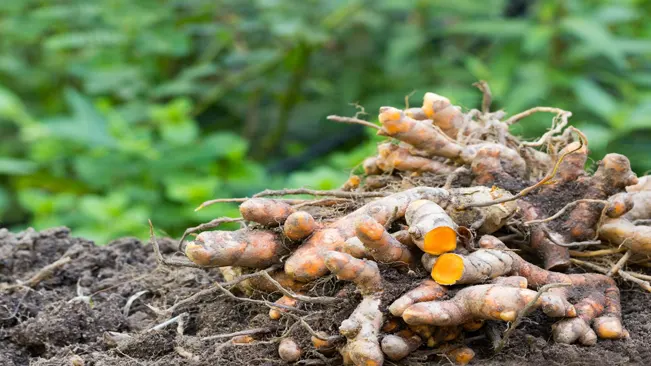
Benefits of Turmeric
| Benefit | Description |
|---|---|
| Anti-inflammatory | Turmeric contains curcumin, a compound with strong anti-inflammatory properties, making it beneficial in reducing inflammation in conditions like arthritis. |
| Antioxidant Properties | Curcumin also acts as a potent antioxidant, helping to neutralize free radicals in the body, which can reduce oxidative stress and may lower the risk of chronic diseases. |
| Supports Brain Health | Curcumin boosts brain-derived neurotrophic factor (BDNF), which can improve brain function and lower the risk of brain diseases. |
| Heart Health | Turmeric may improve the function of the endothelium, the lining of the blood vessels, which is important for heart health. It’s also known to reduce bad cholesterol and prevent blood clots. |
| Cancer Prevention | Some studies suggest that curcumin can affect cancer growth, development, and spread at the molecular level and may help reduce angiogenesis (growth of new blood vessels in tumors) and metastasis (spread of cancer). |
| Alleviates Depression | There’s evidence to suggest that curcumin can boost serotonin and dopamine levels, potentially helping in treating depression. |
| Treatment of Alzheimer’s Disease | The anti-inflammatory and antioxidant properties of curcumin might play a role in preventing and treating Alzheimer’s disease by clearing amyloid plaques, a hallmark of Alzheimer’s. |
| Eases Symptoms of Arthritis | Due to its anti-inflammatory properties, turmeric is effective in reducing symptoms of arthritis and is sometimes more effective than anti-inflammatory drugs. |
| Delays Aging and Fights Age-Related Diseases | The antioxidant and anti-inflammatory properties contribute to anti-aging benefits. Combined with a boost to brain function and heart health, turmeric can play a role in delaying aging and preventing age-related chronic diseases. |
| Digestive Health | Turmeric can help in managing digestive issues like inflammation of the digestive tract, and may also help in cases of dyspepsia, peptic ulcers, and IBS. |
List on How To Grow Turmeric
Selecting a Planting Spot
Climate Requirements

- Understanding Turmeric’s Tropical Origin: Turmeric is native to Southeast Asia and thrives in a tropical environment. This background is key to understanding its climate needs.
- Importance of Humidity: In addition to warm temperatures, turmeric benefits from a humid environment. If your area lacks humidity, especially when growing indoors, consider using a humidifier or regularly misting the plants.
- Adapting to Cooler Climates: In regions with cooler climates, growing turmeric outdoors might be challenging. However, it can thrive indoors or in a greenhouse where the environment can be controlled. Utilizing grow lights and heating mats can help replicate the warm conditions turmeric needs.
Soil Preparation

- Ideal Soil Type: Turmeric prefers loamy soil – a mix of sand, silt, and clay – which offers good drainage and nutrient retention. The soil should be light and fluffy, not compact, allowing roots to expand easily.
- Drainage Is Crucial: Good drainage is essential to prevent waterlogging, which can cause root rot. If you’re using containers, ensure they have drainage holes. In garden beds, consider raised beds or amend the soil to improve drainage.
- Nutrient-Rich Environment: Turmeric is a heavy feeder, requiring nutrient-rich soil to grow optimally. Incorporating organic matter like compost or well-rotted manure adds essential nutrients. Compost not only enriches the soil but also improves its structure and water-holding capacity.
- pH Level Consideration: The ideal soil pH for turmeric is slightly acidic to neutral (around 5.5 to 7.0). If necessary, test the soil pH and adjust it by adding lime (to raise pH) or sulfur (to lower pH).
Planting Turmeric
Obtaining Turmeric Rhizomes

- Selection: Choose firm, healthy rhizomes with a bright, orange hue. Avoid any that are soft, wrinkled, or showing signs of rot.
- Organic vs Non-Organic: Organic rhizomes are preferable as they are less likely to have been treated with growth retardants which can inhibit sprouting.
- Eyes or Buds: These are the small knobs or protrusions on the rhizome. They are crucial as they’re where the new growth will sprout from.
Planting Time
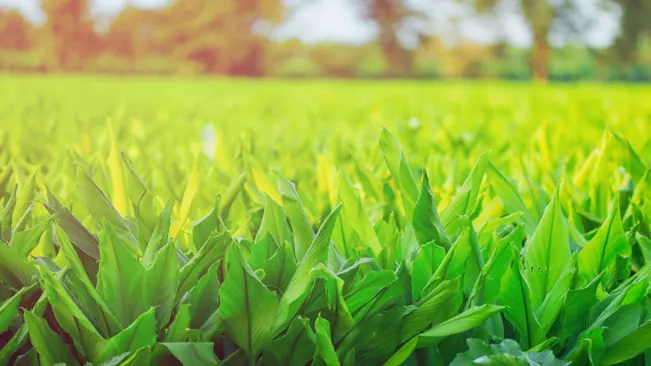
- Climate Consideration: Turmeric is a tropical plant, so the timing of planting can vary based on your local climate. In cooler regions, planting after the last frost is essential.
- Indoor Planting: If you live in a particularly cold climate, starting the rhizomes indoors and transplanting them outside when the weather warms up can be a good strategy.
- Season Length: Since turmeric requires a long growing season (about 8-10 months), ensure that you plant early enough in the season for the plants to mature before the first fall frost.
Planting Process
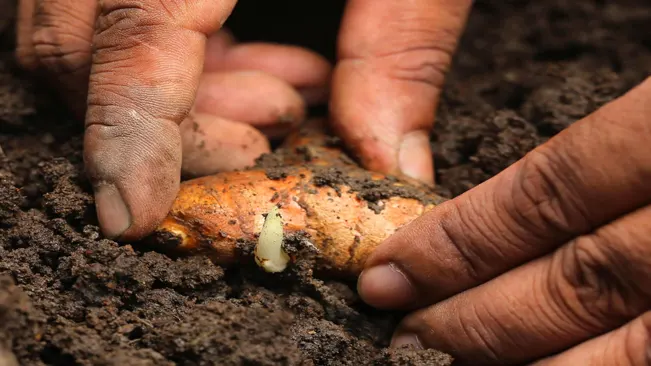
- Soil Preparation: The soil should be well-draining and rich in organic matter. If you have heavy or clay-like soil, consider amending it with sand or planting in raised beds or containers to improve drainage.
- Depth and Orientation: Planting the rhizomes two inches deep allows for enough soil coverage without burying them too deeply. Make sure the buds are facing upwards, as this is the direction the new shoots will grow.
- Spacing: Adequate spacing between the rhizomes ensures each plant has enough room to grow. Overcrowding can lead to competition for nutrients and water, reducing the yield.
- Watering Post-Planting: After planting, water the soil well to help settle it around the rhizomes. However, be cautious not to overwater, as turmeric rhizomes are prone to rot in excessively wet soil.
Caring for Your Turmeric Plants
Watering
- Consistency is Key: Turmeric’s tropical origin means it’s accustomed to regular rainfall. Aim to keep the soil consistently moist but not waterlogged.
- Monitoring Soil Moisture: Check the soil moisture regularly, especially during dry spells. The top inch of the soil should feel moist to the touch.
- Watering Technique: Water gently and directly at the soil level to avoid wetting the foliage, as this can invite fungal diseases.
Sunlight and Temperature

- Light Requirements: Turmeric grows best in partial shade. If you’re growing it in a region with intense sunlight, provide some shade during the hottest part of the day.
- Ideal Temperature: It thrives in warm conditions, ideally between 68°F and 86°F (20°C – 30°C). If temperatures drop below this range, particularly at night, consider using a cloche or bringing potted plants indoors.
Fertilizing
- Type of Fertilizer: A balanced, organic fertilizer, such as a 10-10-10 NPK formula, is suitable. You can also use compost or well-rotted manure as a natural alternative.
- Frequency of Application: Apply fertilizer every two months during the growing season. Over-fertilizing can harm the plant, so it’s better to err on the side of caution.
- Application Method: When applying fertilizer, follow the instructions on the product’s label and avoid direct contact with the plant stems or leaves to prevent burn.
Weeding and Mulching

- Regular Weeding: Keep the area around your turmeric plants free from weeds, which compete for nutrients and water. Hand-weeding is often the best approach to avoid disturbing the turmeric rhizomes.
- Benefits of Mulching: Mulching helps maintain soil moisture, regulate soil temperature, and suppress weed growth. Organic mulches like straw, bark, or compost are excellent choices.
- Depth and Frequency: Apply a 2-3 inch layer of mulch around the plants, being careful not to pile it up against the stems. Refresh the mulch as needed throughout the growing season.
Harvesting Turmeric
Harvesting Turmeric

When to Harvest
- Turmeric is usually ready for harvest about 7-10 months after planting, primarily depending on the climate and growing conditions.
- The most evident sign that turmeric is ready for harvest is the changing appearance of the leaves and stems. When they start to turn brown and dry, it’s an indicator that the rhizomes have matured.
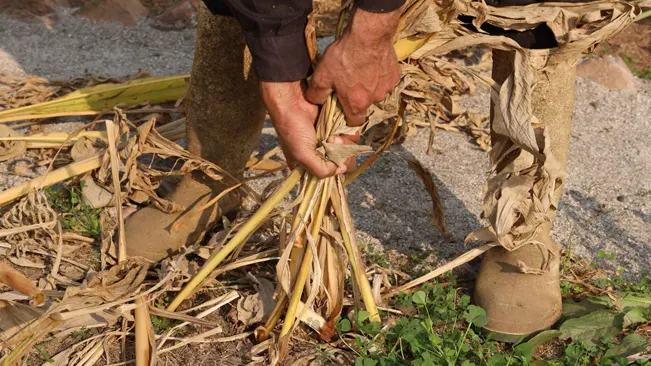
How to Harvest
- Start by carefully removing any mulch or soil around the base of the plant to expose the rhizomes.
- Use a garden fork or a spade to gently dig into the soil around the plant. Be careful to start a few inches away from the base to avoid damaging the rhizomes.
- Gently lift the clump of turmeric out of the ground. If the plant is large, you might need to loosen the soil further or dig from different sides.
- Shake or brush off the excess soil, and then rinse the rhizomes with water to remove any remaining dirt.
Curing and Storing Turmeric
Curing Process
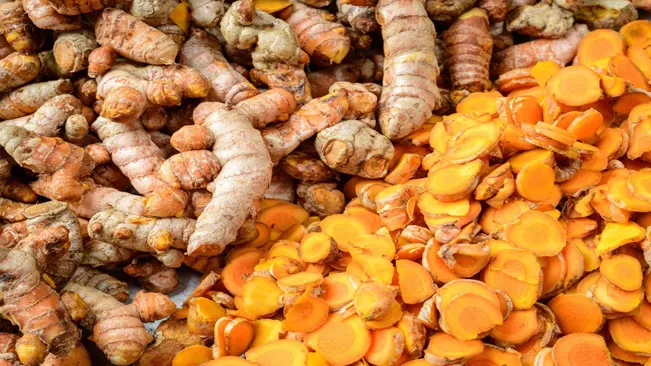
- Curing turmeric involves cleaning and drying the rhizomes to extend their shelf life.
- After harvesting, wash the rhizomes thoroughly to remove all soil. This can be done under running water with a soft brush.
- Pat them dry with a clean cloth. Some people prefer to peel the rhizomes, but this is optional and mainly done if you intend to use them for cooking soon.
Drying
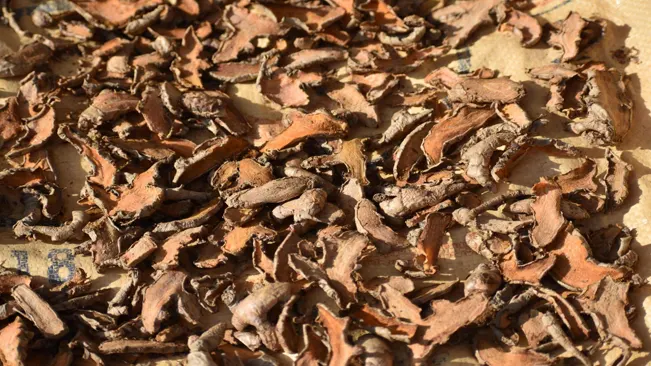
- The rhizomes should then be left to dry in a well-ventilated, shady place. Direct sunlight can cause them to lose some of their vibrant colors and flavors.
- This drying process, or curing, can take a few days to a week, depending on the humidity and air circulation in the area.
Storing

- Once the turmeric rhizomes are dried, they can be stored in a cool, dry place.
- For long-term storage, put them in airtight containers and keep them in a cool, dark location like a pantry or cupboard.
- You can also freeze turmeric rhizomes. To use, grate or break off a piece directly from the frozen rhizome.
Using Fresh Turmeric

- Fresh turmeric can be used immediately after washing and drying. It can be grated into dishes for a fresher and more vibrant flavor than dried turmeric powder.
Related Growing Guides:
Conclusion
Cultivating turmeric offers a rewarding and fulfilling journey. By investing time and providing attentive care, you have the opportunity to reap your garden’s ‘golden spice.’ This not only infuses your culinary creations with a fresh and robust taste but also allows you to benefit from its myriad health advantages.
FAQs (Frequently Asked Questions)
- What is the best time to plant turmeric?
Turmeric should be planted in the spring or after the last frost, as it requires a long, warm growing season. - How do I prepare the soil for planting turmeric?
The soil should be loamy, rich, and well-draining. Enrich it with compost or well-rotted manure to increase fertility. - Can I grow turmeric from supermarket turmeric?
Yes, you can start with organic turmeric rhizomes from a supermarket. Ensure they have some buds or ‘eyes’ for sprouting. - How deep should I plant turmeric rhizomes?
Plant turmeric rhizomes about 2 inches deep with the buds facing upwards. - How much water does turmeric need?
Turmeric requires consistently moist soil. Water regularly, but avoid overwatering to prevent root rot. - Does turmeric need full sun?
Turmeric prefers indirect sunlight or partial shade. Protect it from intense midday sun, especially in hot climates. - How long does it take for turmeric to grow?
Turmeric typically takes about 7-10 months to mature and be ready for harvest. - When and how do I harvest turmeric?
Harvest turmeric when the leaves and stems start to brown and dry. Gently dig around the plant to lift the rhizomes. - Can I grow turmeric in a container?
Yes, turmeric can be grown in containers. Ensure the container is large enough and has good drainage. - How do I store harvested turmeric?
Clean the rhizomes and cure them in a cool, dry place. Once cured, you can store them in airtight containers or use them fresh.

Kristine Moore
Forestry AuthorI'm Kristine Moore, a seasoned garden landscaping professional with over 30 years of experience. My extensive career has been dedicated to transforming outdoor spaces into stunning, sustainable landscapes. With a deep understanding of horticulture, design principles, and environmental stewardship, I have become a respected figure in the field, known for creating harmonious, visually appealing, and eco-friendly gardens. My commitment to excellence and continuous learning in landscaping trends and techniques has solidified my reputation as an expert in garden design and implementation.













Leave your comment